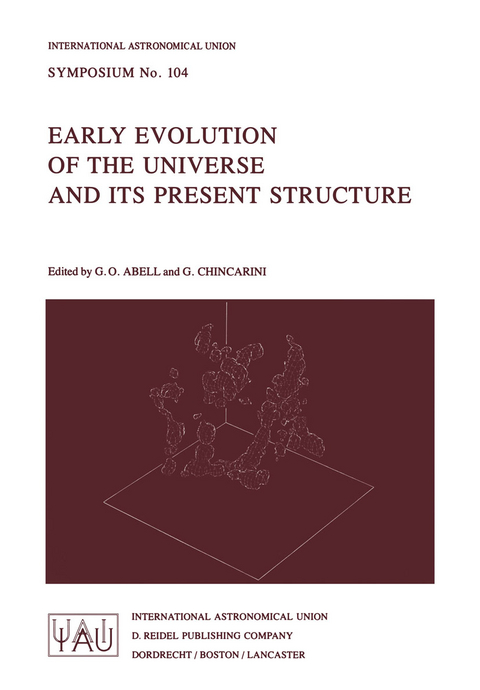
Early Evolution of the Universe and its Present Structure
Kluwer Academic Publishers (Verlag)
978-90-277-1662-0 (ISBN)
Keynote: Structure of the Universe.- X-Ray Sources of Cosmological Relevance.- THE e+-e- Annihilation Line and the Cosmic X-Ray Background.- QSO Surveys and Quasar Evolution.- Automated Quasar Detection.- The Asiago Catalogue of Quasi Stellar Objects.- The Quasar Redshift Limit.- Energy Distribution and Variability of BL LAC Objects. The cases of PKS 2155–304 and 3C 66A.- Long-Term Variability of Quasi-Stellar Objects, and Their Distribution in the Hubble Diagram.- Radio-Source Evolution and the Redshift Cut-Off.- A Model for the Cosmological Evolution of Radio Sources.- Quasar Galaxies: Two-Dimensional Image Deconvolutions.- QSO Luminosities at ? 1 MM.- QSO Redshift Limit and Periodicity in a FIB Universe.- Unbiased Searches for Quasars Beyond a Redshift of 3.5.- The Problem of the Redshifts.- The Evolution of the Radio Galaxy Population as Determined from Deep Radio-Optical Surveys.- A 6-CM Deep Sky Survey.- Near Infrared Photometry of Faint Radio Galaxies.- Near Infrared and Radio Observations of Distant Galaxies.- Studies of Faint Field Galaxies.- JF Photometry of Fourteen Distant Rich Clusters of Galaxies.- Color Distribution of Faint Galaxies and Quasi-Stellar Objects.- Spectroscopy of Distant Galaxies in Clusters.- A Redshift Survey of Very Faint (B?22.5) Field Galaxies, Radio Sources, and Quasars.- Spectral Energy Distributions of Galaxies in Moderate Redshift Clusters.- Distortion of the Microwave Background by Dust from Population III.- Was the Big Bang Hot?.- On Population III Star Formation.- Search for Small Scale Anisotropy of the 3K Emission of the Universe.- New Limits to the Small Scale Fluctuations in the Cosmic Background Radiation.- 10 to 60 Arcmin Fluctuations in the Cosmic Microwave Background.- Deep Radio Source Counts and Small ScaleFluctuations of the Microwave Background Radiation.- Measurement of the 3 K Cosmic Background Noise in the Far Infrared.- On the Large-Scale Anisotropy of the Cosmic Background Radiation in the Far Infrared.- Large-Scale Anisotropy at Centimeter Wavelengths.- Large-Scale Anisotropy of the Cosmic Relic Radiation in Spatially Open Cosmological Models.- Comments and Summary on the Cosmic Background Radiation.- Redshifts and Large Scale Structures.- The Center for Astrophysics Redshift Survey.- The Anglo-Australian Redshift Survey.- Catalogue of Radial Velocities of Galaxies.- The Southern Cluster Survey.- Catalogue of Clusters that are Members of Superclusters.- Characteristic Size of Superclusters.- Quasars and Superclusters.- Further Investigations on Possible Correlations between QSOs and the Lick Catalogue of Galaxies.- Survey of the Bootes Void.- On the Origin of the Voids.- Properties of Galaxies in Low Density Regions.- Dynamics of Voids and Clusters and Fluctuations in the Cosmic Background Radiation.- Condensations and Cavities.- Correlation Functions, Microwave Background, and Pancakes.- A Photometric and Morphological Investigation of Very Remote Clusters.- Supernovae as a Cosmological Tool.- Substructure in Clusters of Galaxies.- Filaments.- Morphology of the Local Supercluster.- The Kinematics of the Local Supercluster.- Superclusters as Nondissipative Pancakes.- The Motion of the Local Group of Galaxies with Respect to the Background of Galaxies.- Infall of Galaxies into the Virgo Cluster.- Diameters of HI Disks in Virgo Cluster — and Field Galaxies.- Evidence of Intrinsic Correlation between the Luminosity and the Velocity Dispersion in Galaxy Groups.- Structure of Neighboring Superclusters: A Quantitative Analysis.- The Perseus Supercluster.- The UrsaMajor Supercluster.- Dynamics of Some Remote Superclusters.- A2197 + A2199 Supercluster Region.- The Indus Supercluster.- The Southwest Extension of the Perseus Supercluster.- The Horologium Supercluster.- Unseen Mass.- Neutrino Mass and Galaxy Formation.- Massive Neutrinos and Ultraviolet Astronomy.- What does the Dynamical Analysis of Clusters of Galaxies Tell Us about Massive Neutrinos?.- Multimass Models for Clusters of Galaxies.- Perturbations in the Universe with Massive “...Inos”.- Black Holes and the Fate of a Closed Universe.- The [an] Isotropy of the X-Ray Sky.- Hot Accretion Disks and the High Energy Background.- X-Ray Observations of Active Galactic Nuclei.- QSO Absorption Lines.- Absorption Structure in the BL LAC Object 0215+015 at 20 Km S-1 Resolution.- High-Redshift Molecular Clouds and Absorption-Line Spectra of Quasars.- The Statistic Study of L? Absorption Lines.- Absorption-Line Spectroscopy of Close Pairs of QSOs.- Evolutionary Effect in Quasars as a Consequence of Galaxy Formation Process.- Are QSOs Gravitationally Lensed?.- Can All Quasars be Gravitationally Lensed SY’s Nuclei?.- Statistical Analysis of Optically Variable QSOs and Bright Galaxies: A Hint for Gravitational Lenses?.- Nature of ‘Unseen’ Galactic Envelopes.- The Theory of Large-Scale Structure of the Universe: Local Properties and Global Topology.- Self-Similar Gravitational Clustering.- Monte-Carlo Simulations of the Distribution of Faint Galaxies.- Neighboring Superclusters and their Environs.- Numerical Experiments on Galaxy Clustering.- Relativistic Stellar Dynamics.- Spherical and Toroidal Local Black Holes.- Possible Contraction of the Members of the Binary Pulsar PSR 1913+16 and its Astrophysical Consequences.- Observational Tests of Baryon Symmetric Cosmology.-Particle Phase Transitions can Prevent an Initial Cosmological Singularity.- Acceleration and Dissolution of Stars in the Antibang.- Inflationary Universe, Primordial Sound Waves and Galaxy Formation.- Phase Transitions of Cosmological Vacuum and Primordial Black Holes.- Unified Gauge Theories and Galaxy Formation.- Physics of the BI-Partition of the Universe.- Causal Structure of the Early Universe.- R2 Gravity and the Structure of the Universe.- The Strong Equivalence Principle and its Violation.- The Role of Particle Physics in Cosmology and Galactic Astronomy.- Index of Names.- Index of Subjects.
| Erscheint lt. Verlag | 30.9.1983 |
|---|---|
| Reihe/Serie | International Astronomical Union Symposia ; 104 |
| Zusatzinfo | 564 p. |
| Verlagsort | Dordrecht |
| Sprache | englisch |
| Maße | 170 x 244 mm |
| Themenwelt | Naturwissenschaften ► Physik / Astronomie ► Astronomie / Astrophysik |
| Naturwissenschaften ► Physik / Astronomie ► Relativitätstheorie | |
| Naturwissenschaften ► Physik / Astronomie ► Theoretische Physik | |
| ISBN-10 | 90-277-1662-5 / 9027716625 |
| ISBN-13 | 978-90-277-1662-0 / 9789027716620 |
| Zustand | Neuware |
| Haben Sie eine Frage zum Produkt? |
aus dem Bereich


